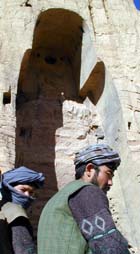Andrew
Maykuth Online
|
 |
Militiamen stand in front of the cavity where one of the ancient giant Buddhas was located before it was destroyed by the Taliban.. |
BAMIYAN,
Afghanistan - It took the Taliban four days in March to destroy two giant
Buddhas carved from the cliffs in this spectacular valley - less than 100
hours to wipe out 17 centuries of history.
Now,
with the Taliban routed, the returning exiles of Bamiyan are dealing with
the damage wrought by war, and by the rule of the Islamic extremists.
"It
was very sad to come back here and see the Buddhas were gone," said
Karim Khalili, an ethnic Hazara political leader and military commander
who was responsible for the Northern Alliance push into the area.
"One of the most beautiful things about Bamiyan is no longer here. It
has been destroyed."
Two
huge, empty niches remain in the face of the tan sandstone wall, a
reminder to future generations that something great once stood here. Only
dust and a few boulders are left; the Taliban carried most of the debris
away.
"It
was sad they were destroyed, because it was a historic site and part of
the heritage of the people," Khalili said. "It was a cruelty,
not only against the people of Afghanistan, but the whole world."
Afghanistan's
patrimony - as much as the thousands killed and the millions made homeless
- has been a victim of 23 years of war. The Soviets, the mujaheddin and
the Taliban have all contributed to the looting of the National Archives
and the emptying of the Kabul Museum. Many of the country's archaeological
sites have been chiseled away, the artifacts sold in bazaars of
neighboring countries.
The
Taliban's leaders aren't the first to build new temples on the ruins of
old ones. But their contorted interpretation of Islam made them
particularly zealous about expunging any traces of previous cultures.
The
black-robed mullahs who banned music and frowned on secular pleasure so
hated the pilgrimages that fans made to the grave of Ahmed Zaher, a wildly
popular singer of love songs who died in 1979, that they planted
explosives on his tomb and blew it to bits.
Opposed
to any depiction of the human face, they prohibited photography and
movies.
And
early this year the Taliban's supreme leader, Mullah Mohammed Omar -
citing the Koran's injunction against idol worship - ordered the
destruction of any and all statues in Afghanistan, calling them "gods
of the infidels." It was a death warrant for the Buddhas of Bamiyan.
There
once were thousands of carvings of Buddha in the region. The two giant
statues were the most remarkable; the smaller one, about 120 feet tall,
was carved in the third century, the larger, 175 feet tall, in the fifth.
"People
loved them because they were historic things," said Naroz Ali, 25,
one of the few residents of the largely deserted town to watch as the
giant Buddhas were blasted with a barrage from tanks, mortars and rockets.
The
Bamiyan Valley is rich in history. Alexander the Great once marched his
army through this cleft high in the mountains on his way to India. There
are vestiges here of Genghis Khan, Tamerlane and Babur, the founder of the
Mughals.
At
the height of the Roman Empire, Bamiyan was an important way station for
caravans on the web of pan-Asian trade routes known collectively as the
Silk Road, connecting China with Rome and all points between.
The
caravans also carried ideas, Buddhism among them, and Bamiyan became one
of the outposts of that Indian-born faith. King Kanishka, whose Buddhist
Kushan dynasty stretched from northern India to the Caspian Sea, grew
wealthy from trade and constructed the first of the two colossal Buddhas.
Buddhism
flourished in Bamiyan, a city built on the floor of a valley today covered
by green fields of winter wheat, almond trees, and nearly leafless
poplars. Pilgrims and monks came here to worship, carving three tiers of
caves into the rocks, painting some with frescoes celebrating the cult of
the Buddha.
With
the influx of Islam from the Middle East in the seventh century, Buddhism
declined, and by the 10th century nearly everyone was Muslim.
Various
invaders left their marks on the Bamiyan Buddhas. British soldiers in the
19th century were said to have fired guns at the statues.
In
1998, after bringing Bamiyan under its control, the Taliban presaged last
spring's assault by dynamiting the face off the smaller Buddha and firing
rockets at it.
Finally,
in March - weeks after announcing its plans and repeatedly rejecting
international pleas to reconsider - the Taliban sent soldiers to destroy
the Buddhas, ordering local residents to stay out of the way.
Mohammed
Ali, a farmer who watched from a distant hill, said the barrage was
relentless. "The dust was all over the place," he said.
Afterward,
the Taliban ordered the townspeople to sacrifice some sheep to mark the
occasion; 50 were killed.
"When
they finished, they were very happy - they were firing in the air,"
said Naroz Ali, who had seen the attack from the town bazaar.
The
bombardment severely damaged the rock around the statues. The irregular
spiral staircases excavated inside the niches have deep cracks and are in
danger of collapse; the niches' roofs also are fractured.
Some
have suggested rebuilding one or both of the statues, but the U.N.
Educational, Scientific and Cultural Organization frowns on reconstruction
of destroyed monuments, believing that pieces of the cultural heritage are
irreplaceable.
"People
here loved the Buddhas," said Abdullah Noori, 27.
Khalili,
the local guerrilla commander and leader of the Hezb-i-Wahdat party, said
that while his group would guarantee the safe passage of archaeologists to
study the damage, the Northern Alliance had many more pressing concerns
than rebuilding statues.